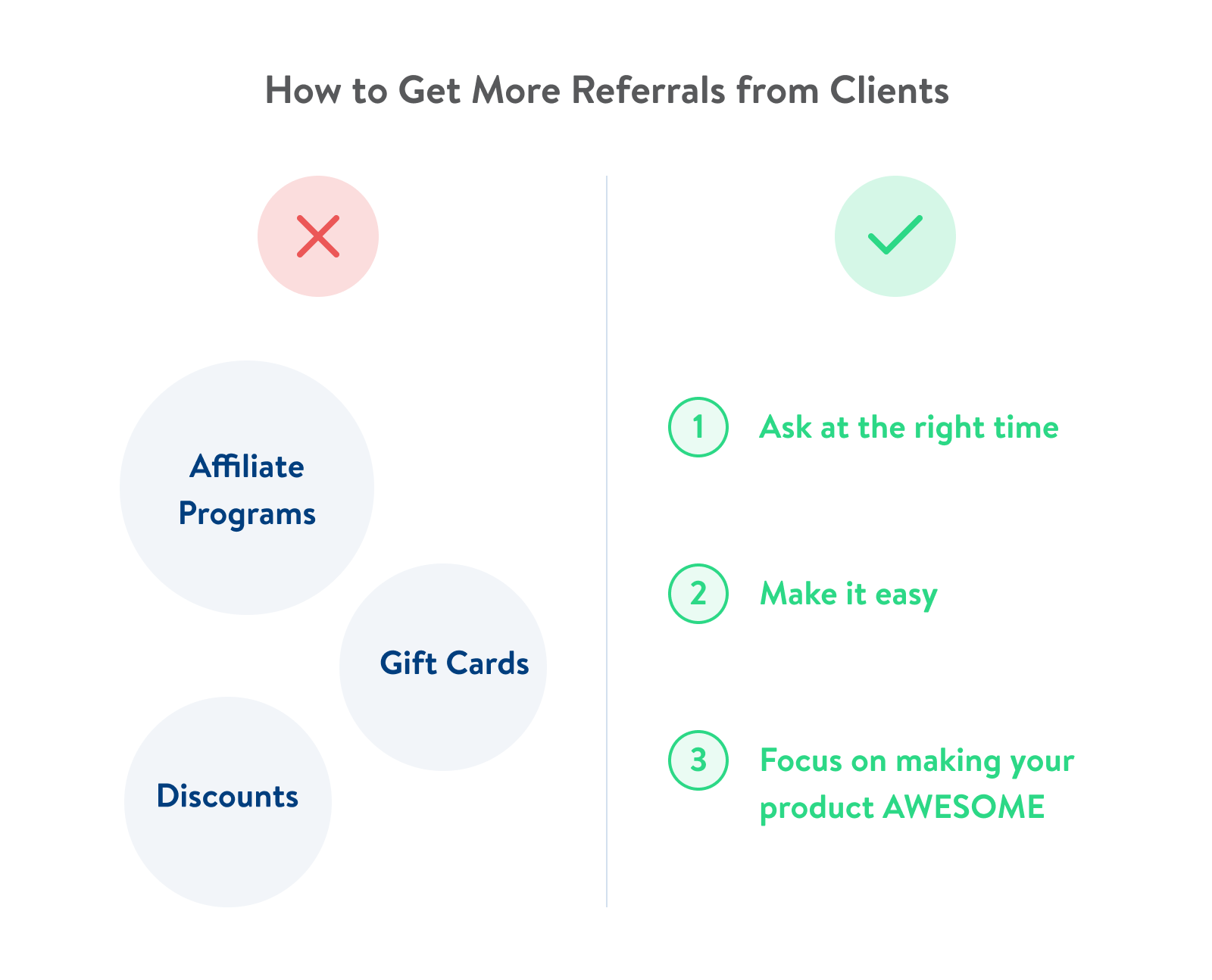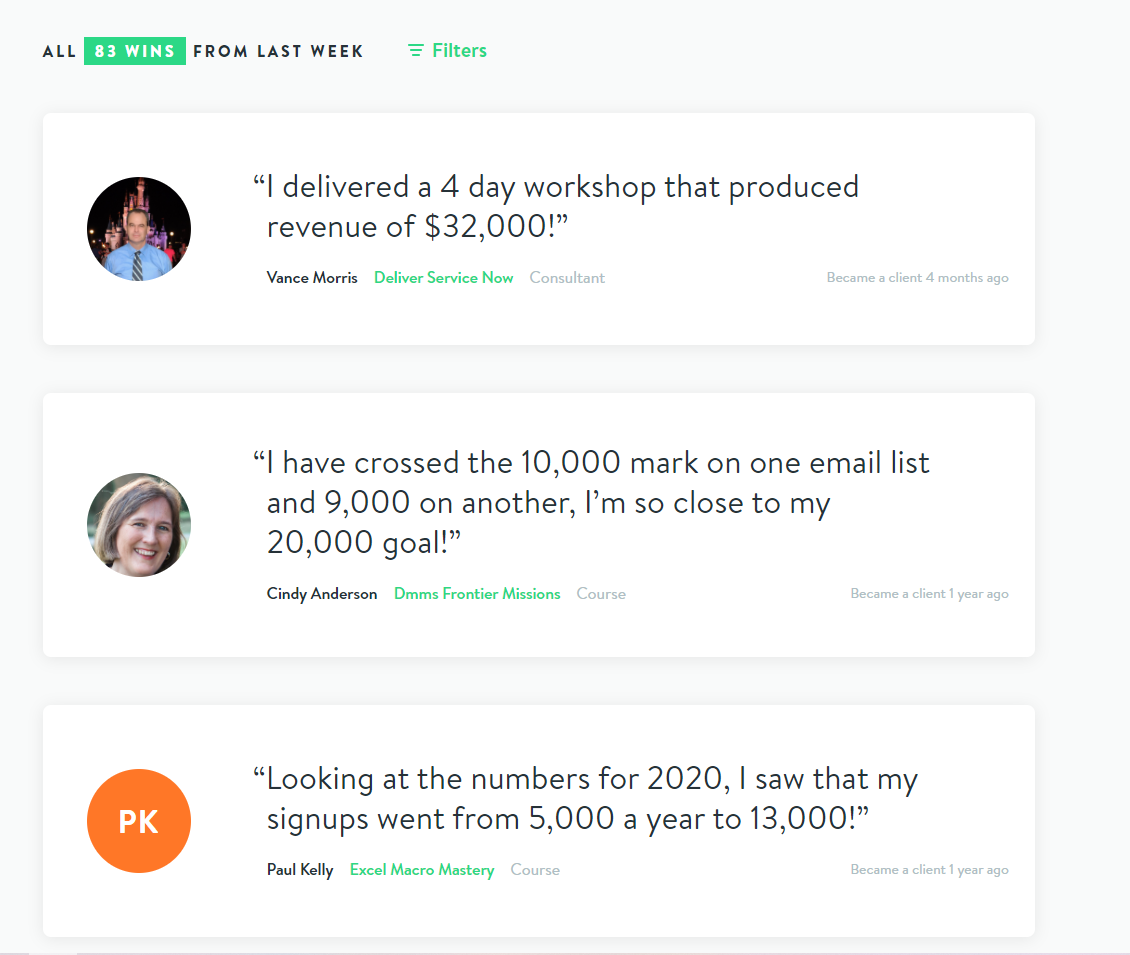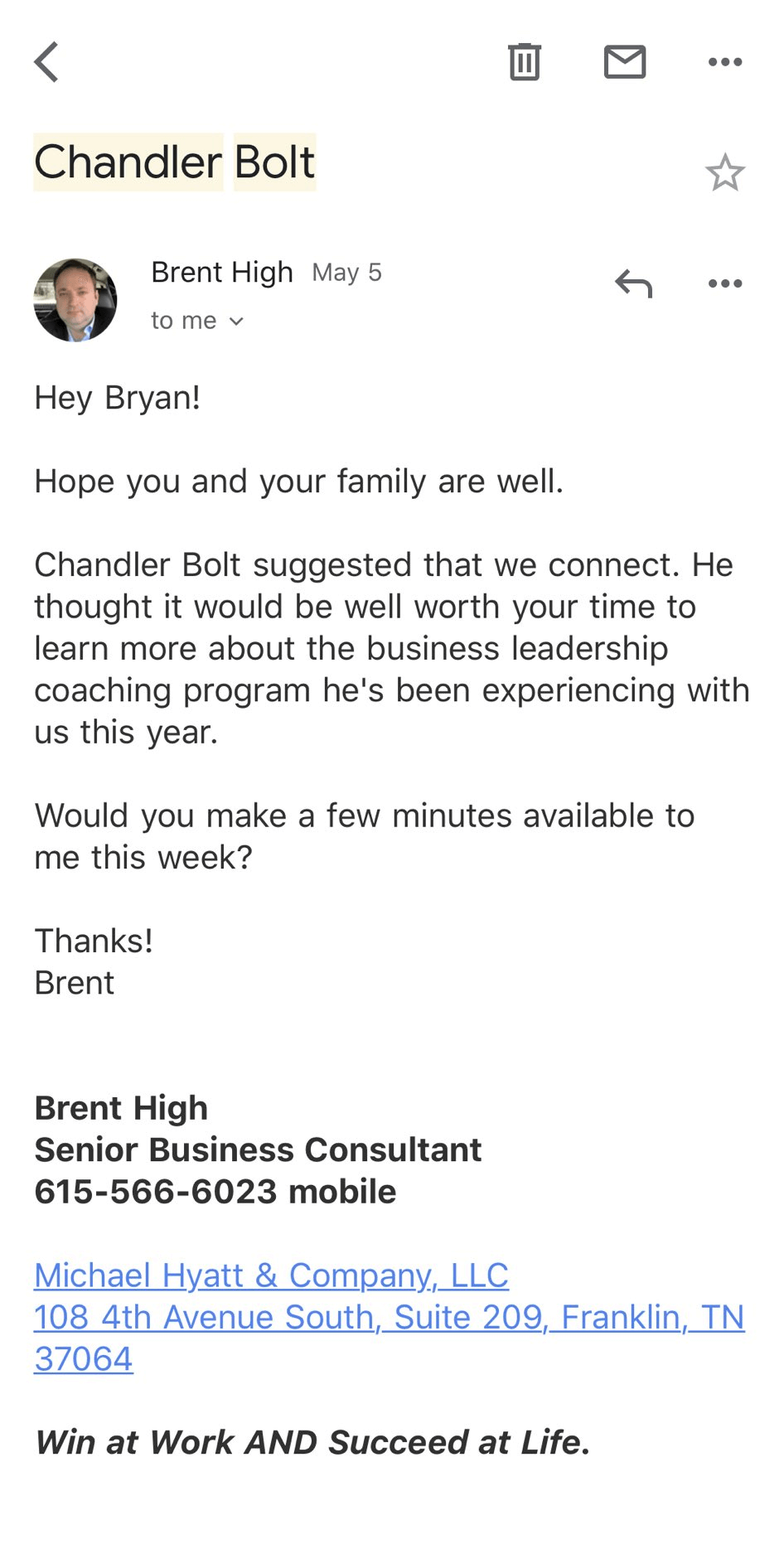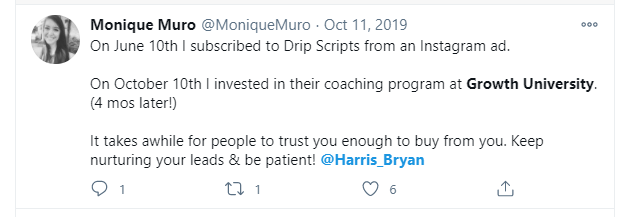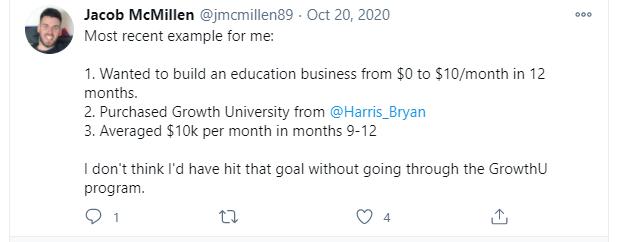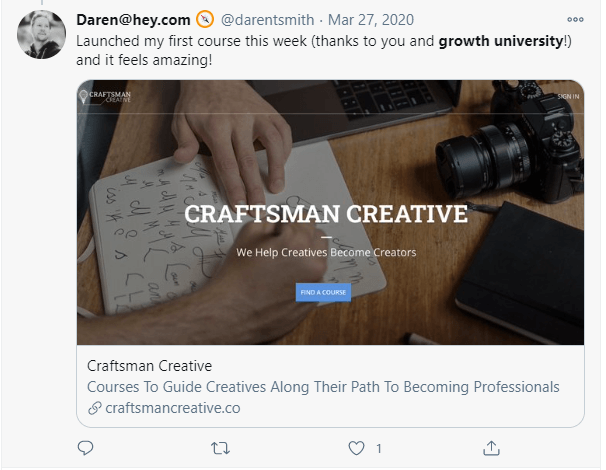Some business owners think they have to offer affiliate payments, monthly gift card drawings, discounts, loyalty programs, and a million other little incentives and tricks to get enough referrals to support some fraction of their overall business growth.
But you don’t need 15 different tactics to get new clients from referrals. All you need to get more referrals is to follow the one, straightforward process we’ve used to put referrals on autopilot in our business.
It’s actionable and easily adaptable to any coaching, consulting, or online course business. And it doesn’t take 20 hours a week.
Our client referral strategy has three parts:
- When it makes the most sense to ask clients for referrals.
- How to make it easy for clients to refer you (whether it’s to one person or a group of people, like their social media following).
- The secret to getting glowing, unprompted referrals and more new customers than you can handle.
This is the same process we’ve used for our marketing coaching program, and in this post, we’ll explain it to you in great detail, so that you can tweak it for your own business and apply the learnings.
Let’s get to it!
Looking for proven, step-by-step methods to grow your course or coaching business? Book a complimentary strategy session where we’ll audit your business strategy and talk through a 90-day plan to skyrocket revenue and create a predictable lead flow.
When and How to Ask Your Clients for Referrals
If you offer a phenomenal experience that helps your current customers achieve the results they want, then you’ll get some word-of-mouth referrals just for being that awesome.
But what if you’re still iterating toward the “perfect” product? Or those handful of glowing customer referrals aren’t growing your business fast enough?
That’s when you build in a standard process to prompt client referrals. You make a plan to ask them in the right way at the times they’re most likely to say yes.
The two questions that you need to get right are:
- When does it make the most sense to ask clients for a referral?
- How are you going to ask clients for a referral?
Here’s how to answer those questions.
When Does It Make the Most Sense to Ask Clients for a Referral?
While the answer to this question depends on your specific sales process, here are a few situations that apply to most businesses:
1. After They’ve Made a Purchase
One of the highest points of excitement for clients is right after they’ve made a purchase. They’re bought in on what you offer, but they haven’t had a chance to lose enthusiasm (whether that’s your fault or theirs).
That makes it a great time to ask for a referral, especially if you’re still ironing out problem spots in your product or service.
If part of your process is to schedule an onboarding call or even send a “Thanks for buying, here’s what’s next” type of message via email, then in that same email, you can include a P.S. message along the lines of, “Do you have any friends that you think would be a good fit as well?”
2. After They’ve Experienced a Win
Another natural point where you could ask existing customers for referrals is right after they’ve experienced a win. This is hands-down one of the best times to do it because they have proof that what you do works.
Say you run an email marketing agency, and you’ve just sent out a campaign that resulted in over 100 conversions when they were only getting 20 a few months prior. They now think your secret sauce works like gangbusters and should have no reservations about recommending you to their network.
But here’s the thing: You have to ask! This isn’t the time for false modesty. Just ask them after you report the results, “Hey, do you know anyone else who would be a good fit for our agency?”
If they do, they’re much more likely to tell you now that you’ve proven your worth.
3. After They’ve Renewed or Purchased an Additional Product
Say you run a three-month coaching program that clients can choose to renew. Build a hook into your process where, if a client has renewed for another three months, an automatic email goes out to them asking them for a referral.
Or, if you run an eCommerce company, and a client has made a purchase on your site for the third time (just as an example), that’s another natural point where you can reach out to them for a referral. Presumably, repeat customers are happy customers, so they’re ones you want to send a referral request.
4. After They’ve Submitted a Testimonial
When a client submits a positive testimonial, you can use that as the stepping stone to ask them for a referral. They’re more likely to agree because they’ve already spent time writing or shooting a video to describe their experience, making them more excited about your offering.
You can also share those testimonials with your team to increase morale and motivation. People often get too in the weeds and forget why they’re doing something, so it’s great to remind them about the results your customers are getting.
Note: At Growth Tools, we’ve systematized the collection of customer success stories, and we get 120 client wins every week, as you can read about in this case study. If you don’t have a process in place to get more testimonials for your business, then this is a must-read!
Here’s an example just from last week:
Make It Easy for Your Clients to Refer You
Once you build a process to prompt your current clients for referrals at various stages of your business (and they agree), how do you make it painless for them to do the referring?
Give them swipe copy with the “base ingredients,” so they have an easy place to start. To give you a better idea of how to do so effectively, we’ll share examples of swipe copy that you can use in two cases:
- When someone refers you to a single individual they know (i.e., swipe copy that the client could use to send a direct message to their friends and/or colleagues).
- When someone refers you to a group of people (i.e., swipe copy that the client could use to share your product with their followers on Twitter or LinkedIn, their email list, and so on).
The swipe copy you’d end up using in both of these scenarios is quite different because an email someone sends to their friend is a lot more informal than a Tweet to a large audience.
When Someone Refers You to a Single Individual They Know
Once someone agrees to refer you to someone they know, they’ll most likely use text or email to do so, depending on their relationship with that person.
Of course, while you can’t force them to send an email and CC you on it, that’s the ideal approach. If they don’t CC you, they should at least include your contact information.
So, for example, say you ask your client, “Hey, do you know someone?”
And they respond with “Yeah, I have someone in mind that would be a great fit … ”
Then follow up like this:
- Get that person’s name and email address.
- Give the referrer swipe copy that they can work off of.
- Suggest they send that person an email with you CC’d on it, using that copy modified for their voice.
Here’s an example swipe copy that you can send them:
“Hey Grant, this is Bryan. You need to talk with Sam*.
She set up conversion tracking dashboards that show us exactly which channels our leads came through. It’s awesome. Y’all need to hire her.
Anyway, I’ll leave you to it!”
*Note: Have your name hyperlinked to your website so that new clients can still find you easily even if your current client doesn’t CC you on the email.
Many times, they will tailor (or completely rewrite) the copy you provide so that the message is in their own voice. And that’s totally fine. But the swipe copy gives them a place to start and helps them know what they need to include in the message.
If you can’t get them to connect you directly, you could still reach out to the person your client thought of and mention the referral like Brent High did in this email to me:
It is less effective than a direct introduction, but still better than firing off cold emails all day.
When Someone Refers You to a Group of People
Two years ago, I emailed all of our customers to let them know about the new referral program we launched.
Immediately, my inbox was flooded with requests for swipe copy that people could Tweet or email to their lists. Many of your clients will be happy to refer you to their network … if you make it easy for them.
Here are a few examples of what you can give your clients.
Twitter Template
@Harris_Bryan’s coaching program just doubled my coaching revenue in 6 months! Go check him out at https://videofruit.com/blog/.
Email Template (For a Group)
Hey [name],
The past six months I’ve doubled revenue from my course business by following Growth University’s marketing plan. Their coaches tell me exactly what I need to work on and the results speak for themselves.
– Bryan
Since I knew my clients were going to use this swipe copy to promote the product to a large audience, it was less personal than the previous swipe copy example.
Tweak your swipe copy to make it as attractive as possible for new leads. Remember to make it as simple as possible for successful referrals to contact you, whether that’s by emailing you directly or finding the great big “Hire Me” button on your website.
Do this right and messages like this will become the norm. 😎
5 Standards of a Great Product Worth Referring Your Friends To
How do you take all of the strategies we mentioned to the next level?
By building a great product that’s actually worth referring to.
Not only will it allow you to get more prompted referrals, but also more unprompted, word-of-mouth referrals. Like these mentions on Twitter:
The question is, how do you know when you’ve built a great product?
There is no hard and fast rule, but when we measure our own success, we use the following five product metrics to determine this:
- Does each client see a very specific result in a short time period?
- Does each client give you a raving fan testimonial video after receiving the product? (It still counts if you ask for these.)
- Does each client refer two more best-fit clients to you?
- Does each client buy at least 3x?
- Does each client say it was worth 10x what they paid (or they get a refund)?
It won’t be easy to meet these standards of a great product. It will probably take two to three years, and you still might have to adjust these questions for the type of product you sell (for example, if it’s a one-time program, repeat purchases don’t make sense.)
But these questions lead you to concrete steps. If you don’t have a specific win you want each client to achieve, then you can go build that into your client journey. If your customer base rarely tells you that your product or service is worth more than they’re paying, you can start digging and find out why.
And when you do meet those criteria? You’ll be getting more new business than you can handle without raising prices or hiring more help.
Looking for proven, step-by-step methods to grow your course or coaching business? Book a complimentary strategy session where we’ll audit your business strategy and talk through a 90-day plan to skyrocket revenue and create a predictable lead flow.
